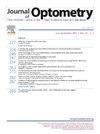Refractive error in preterm infants without retinopathy of prematurity aged 1–18 months: A propensity score matching analysis
IF 1.8
Q2 OPHTHALMOLOGY
引用次数: 0
Abstract
Background
Preterm birth is associated with an increased risk of abnormal refractive development, even without retinopathy of prematurity (ROP). This study aimed to evaluate the differences in refractive error between preterm infants without ROP and full-term infants, as well as to assess the relationship between physical parameters at birth and refractive status in preterm infants.
Methods
A total of 1205 infants aged 1–18 months participated in this cross-sectional study conducted at Tianjin Women’s and Children’s Health Center in China from March 2020 to September 2023. Following One-to-one propensity score matching (PSM), 230 pairs of infants were included. Refraction was examined by cycloplegic refraction, and the mean spherical equivalent (MSE) of both eyes was analyzed. A simple linear regression model was employed to determine the relationships between refractive state and gestational age (GA), birth weight (BW), and birth length (BL) in preterm infants.
Results
Among the 1205 infants, 230 were preterm infants without ROP, and 975 were full-term infants. After PSM, the MSE of preterm infants was lower than that of full-term infants during every period (t = −0.320, P = 0.749). Compared with full-term infants, preterm infants exhibited a significantly higher prevalence of refractive error (P = 0.014), particularly astigmatism (P = 0.040). Although the difference in myopia between the two groups was not significant (P = 0.500), preterm infants had more frequent emmetropia than full-term infants across all stages (P = 0.037). In addition, MSE was negatively correlated with both BW and BL (R2 = 0.260, P < 0.001; R2 = 0.035, P = 0.004); however, there was no correlation between MSE and GA (R2 = 0.048, P = 0.051).
Conclusions
Compared to full-term infants, preterm infants without ROP exhibit lower MSE values and a higher prevalence of refractive errors, particularly astigmatism, and a trend towards developing myopia was observed during early life. BW can be utilized as a parameter to predict the early refractive status of these preterm infants.
1-18个月无视网膜病变早产儿屈光不正:倾向评分匹配分析
背景:即使没有早产儿视网膜病变(ROP),早产也与异常屈光发育的风险增加有关。本研究旨在评估无ROP早产儿与足月婴儿屈光不正的差异,以及早产儿出生时身体参数与屈光状态的关系。方法本横断面研究于2020年3月至2023年9月在中国天津市妇女儿童健康中心进行,共有1205名1-18个月的婴儿参与。遵循一对一倾向评分匹配(PSM),纳入230对婴儿。用麻痹性屈光检查双眼屈光,分析双眼平均球等效(MSE)。采用简单线性回归模型确定早产儿屈光状态与胎龄(GA)、出生体重(BW)和出生长度(BL)之间的关系。结果1205例患儿中,无ROP早产儿230例,足月儿975例。经PSM后,各时期早产儿的MSE均低于足月儿(t = - 0.320, P = 0.749)。与足月婴儿相比,早产儿屈光不正的发生率明显高于足月婴儿(P = 0.014),尤其是散光(P = 0.040)。虽然两组之间的近视差异不显著(P = 0.500),但早产儿在所有阶段的近视发生率均高于足月婴儿(P = 0.037)。MSE与BW、BL均呈负相关(R2 = 0.260, P <;0.001;R2 = 0.035, p = 0.004);而MSE与GA之间无相关性(R2 = 0.048, P = 0.051)。结论与足月儿相比,无ROP的早产儿MSE值较低,屈光不正(尤其是散光)发生率较高,并有早期发展为近视的趋势。体重可作为预测早产儿早期屈光状态的参数。
本文章由计算机程序翻译,如有差异,请以英文原文为准。
求助全文
约1分钟内获得全文
求助全文

 求助内容:
求助内容: 应助结果提醒方式:
应助结果提醒方式:


